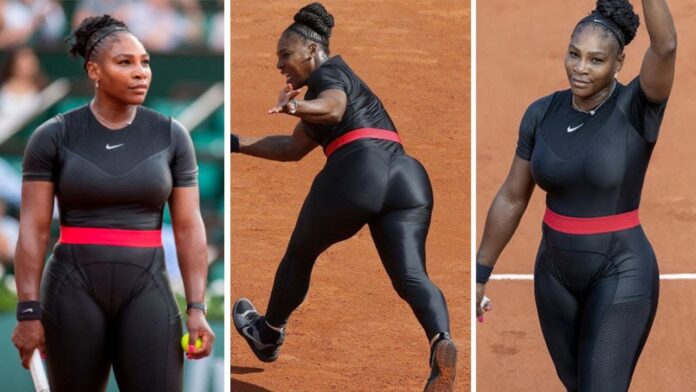Serena Williams stunned fans at the French Open when she stepped onto the court in a catsuit. Black with a red waistband, the full-length bodysuit looked striking on Williams, a new mom; she was likened to a superhero in the ensemble.

But the catsuit won’t be welcome at Roland Garros again. While fans and the media praised the look, French Tennis Federation president Bernard Giudicelli said in a Tennis Magazine interview published Friday that it won’t be back.
“I think we sometimes went too far,” he said. “The combination of Serena this year, for example, it will no longer be accepted. You have to respect the game and the place.”
The catsuit ban led to considerable backlash in the days since it was announced. Williams herself weighed in and said she was not upset by the decision.
But Giuidicelli’s comments ignore the history of the game: Tennis has long been a sport where athletes’ fashion choices have been the source of conflict. Male and female players alike have toed the line when it comes to the dress codes imposed on them, and others have boycotted tournaments altogether because of the required attire. Throughout the history of professional tennis, the trends of the times have influenced player dress. This makes Serena Williams’s Wakanda-inspired catsuit no more disrespectful of the sport than what tennis stars have worn on the court for more than a century.
Fans defended the catsuit because health factored into why Williams wore it
The idea that Williams disrespected the sport by wearing the bodysuit outraged fans because the tennis star explained that she wore the ensemble both with her health in mind and to inspire mothers. Williams has a history of blood clots and developed one after giving birth to her daughter, Alexis, in September via C-section. She dedicated her Black Panther-inspired catsuit to “all the moms out there that had a tough pregnancy.”
“I’ve had a lot of problems with my blood clots,” she said at the French Open. “God, I don’t know how many I’ve had in the past 12 months. I’ve been wearing pants in general a lot when I play, so I can keep the blood circulation going.”
While the ban on such ensembles is still unofficial, Giudicelli’s remark led to backlash. When asked about the catsuit ban, Williams, however, downplayed his remarks.
“I think that obviously the Grand Slams have a right to do what they want to do,” she said.
But for some members of the public, the matter didn’t seem so simple. The suggestion that Serena Williams doesn’t respect the game came across as a microaggression. One of the rare black women to dominate tennis, Williams has faced criticism throughout her career for not looking like the women who’ve traditionally played the sport. Her hair, body, and fashion choices have routinely been scrutinized, often with an undercurrent of race, sex, and class bias.
The Victorian era gave us tennis whites
One reason Giudicelli’s decision to ban Williams’s catsuit has raised eyebrows is because, unlike Wimbledon and its all-white dress code, the French Open has traditionally been a tournament where players can express themselves through fashion. In fact, in 1990 when tournament organizers considered the all-white route, Andre Agassi, known for his colorful ensembles, took offense.
“Somebody doesn’t like me,” he said. “The idea is to make tennis enjoyable for people. Why don’t they take a survey? Instead of asking some old guy behind a desk.”
Tennis whites only became a phenomenon because of Victorian notions of class and hygiene. The sport first caught on in class-conscious Victorian England, where white clothing was associated with wealth and privilege. The lower classes, who worked with their hands, couldn’t wear the color without getting dirty. Victorians also believed that wearing white allowed athletes to sweat with little notice, although women tennis players dressed in a manner that prevented them from real physical exertion.
“When Victorian women played tennis in the 1880s and 1890s, they were wearing their street clothes, which included heavy undergarments like corsets, bustles, and petticoats, and voluminous skirts that grazed the ground,” fashion historian Keren Ben-Horin told Allure.
In the 1900s, women tennis players wore “floor-length skirts, stockings, and long-sleeved tops,” according to Allure. But as the decades went on, new fashions dictated what they wore. That meant flapper-inspired tennis attire in the 1920s, and, later, ’50s-style cardigans and ’60s mod.
In the first half of the 20th century, tennis fashion was not without controversy. Skirt lengths shortened, and American tennis player Gertrude Moran faced backlash for wearing a skirt that revealed a pair of lace shorts underneath. Because of the shorts, she was accused of bringing “vulgarity and sin into tennis.”
What happened to Moran signaled the kind of treatment other women players would face in the years to come. Despite the criticism she received, Moran is considered one of tennis’s early fashion icons.
A white catsuit makes headlines at Wimbledon
Serena Williams’s catsuit may have caused a sensation at the 2018 French Open, but it wasn’t the first time Williams had worn a catsuit during competition. She also wasn’t the first woman tennis player to wear a full-length bodysuit during a Grand Slam contest. During the first round of the 1985 Wimbledon tournament, tennis star Anne White heeded organizers’ all-white rule but defied tradition by wearing a white catsuit instead of a tennis skirt. White’s opponent, Pam Shriver, insulted White’s spandex suit, calling it the “most bizarre, stupid-looking thing I’ve ever seen on a tennis court.” Wimbledon officials apparently agreed and told White not to wear it again to the tournament.
















